Torta al testo is a traditional flatbread sandwich from Umbria stuffed with vegetables, cheeses and cured meats. The torta is cooked on a heavy testo, a circular iron griddle placed directly on the stovetop (long ago, the disc was made from clay and placed over coals in the fireplace).
When I was a student in Perugia with about 10,000 Lira per day to spend on food (about $5 USD back in the pre-Euro days), I regularly frequented a hole-in-the-wall Forno on a narrow cobblestone street near the university that specialized in this savory regional specialty. Each day after classes, I ordered a torta al testo for lunch and brought it up to Corso Vanucci, the wide pedestrian-only promenade in the centro storico that was ideal for people-watching. My favorite filling for these fluffy, oiled flatbreads was peppery arugula , sweet pacchino tomatoes and creamy stracchino cheese. Last summer, during a mini-break from Abruzzo, we visited Umbria, and I returned to Perugia for the first time since 1997. I dragged my husband and three sons around the maze of backstreets behind the university for nearly half hour in search of my beloved Forno. I resigned myself to the fact that I wouldn’t find my old haunt, picked up some pizza al taglio for my hungry kids and set off for Gubbio, where we were staying for a few days. The next day, as we were exploring the lovely medieval town, I asked a local shopkeeper from whom I purchased a testo (called a panaro in Gubbio) where we could enjoy a good torta al testo (which, incidentally, is called crescia in Gubbio) for lunch. They sent us to Osteria dei Re, a charming osteria and wine bar with al fresco dining in a picturesque piazza, where we were treated to the torta al testo of my memories.
Here’s an easy recipe that you can prepare in your favorite well-seasoned cast-iron skillet. Prepare the dough in the morning and enjoy them for lunch or refrigerate the dough overnight and simply bring it to room temperature prior to griddling the flatbreads (the uncooked dough stays very well – How do I know this? Because I was in the process of making the flatbreads for a play-date luncheon when my five-year old broke his collarbone! The remainder of the dough went in the fridge and I prepared it the following day with his favorite filling of fresh mozzarella and tomatoes!). Once griddled, the flatbreads should be enjoyed very soon after you prepare them. They tend to become stale rather quickly. If you need to wait, wrap them tightly in plastic after they cool off and reheat in a whole oven prior to serving and filling. When this crazy Northeast weather finally warms up, I’ll try to cook them on the stone piastra I have for my outdoor grill.
Torta al Testo
From Majella Home Cooking ©
Serves 4
For the Torta:
- 1 tsp. active dry yeast
- 3 cups all-purpose flour
- 1 tsp. sea salt
- 2-3 tbsp extra-virgin olive oil, plus more for drizzling
Ideas for fillings:
- Stracchino or taleggio cheese and baby arugula
- Sauteed greens (spinach, chicory, chard, broccoli rabe, etc.) with grilled or pan-fried sausage
- Tomatoes, fresh mozzarella and basil
- Grilled vegetables
- Italian oil-packed tuna and sun-dried tomatoes
- Speck and fontina
- Prosciutto and shaved Parmigiano or mozzarella di bufala
- Mortadella
- Nutella and bananas (find me something with which Nutella doesn’t pair well!)
In a small bowl, stir together yeast and ½ cup of hot water. Let it sit until foamy, about 10 minutes. Combine flour and salt in a food processor and pulse to combine. Stir 1 tablespoon of olive oil into the activated yeast mixture and with the food processor running, pour it in. Process until a dough forms (i.e., when the ingredients no longer adhere to the sides of the bowl – if the dough is too dry, add some additional cool water, one tablespoon at a time until this happens). Transfer the dough to a lightly floured surface and knead for about 5 minutes. Form the dough into a ball and transfer to a large oiled bowl. Cover the bowl tightly with plastic wrap and allow the dough to rise for about 1½ hours in a warm place.
Punch the dough down (the dough should have doubled in size) and divide it into two balls. Lightly flour one piece of dough and, using a rolling pin, roll it into a 9″ disc. Place the disc on a floured baking sheet, poke it all around with a fork (this will prevent too many air bubbles during cooking) and repeat with the remaining dough.
Heat one tablespoon of olive oil in a 10-12″ cast-iron skillet over medium heat. Working in 2 batches, cook each dough disc, flipping occasionally, until light brown on each side, about 8-10 minutes total.
Lay one of the flatbreads on a cutting board, add your desired filling, place the other flatbread on top, and with a serrated knife, cut the torta into 8 wedges. Drizzle with a little bit more oil and serve.
Buon appetito!
Tagged: bread, Cheese, cured meats, dough, flatbread, griddle, grill, Gubbio, homemade, Italy, lunch, panaro, panini, Perugia, prosciutto, sandwich, testo, Umbria, vegetables

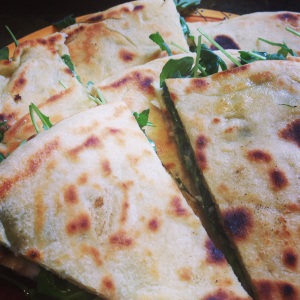
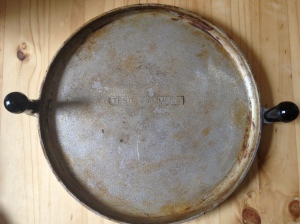
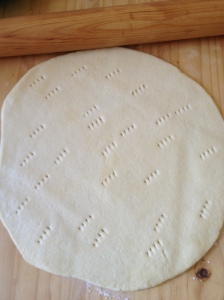
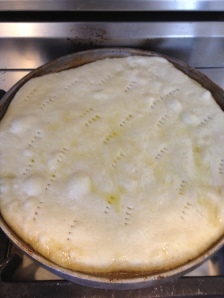
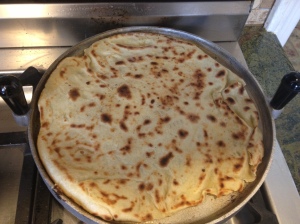
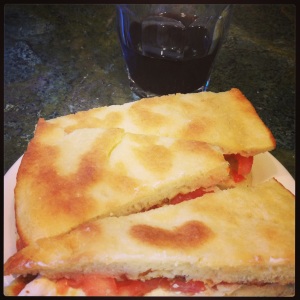
It’s piadina in Abruzzo. They do a nice one at Sunrise Cafe in Vasto along the cliff walk.
Thanks for the tip, Joyce! I am spending a few days in Vasto this summer. Sounds like a perfect post-beach snack!
This looks and sounds divine, will definately try it! Thanks! 🙂
Thank you! Let me know how it turns out!
Thank you! Let me know how it turns out!
Yes, these look like the piadina of Emilia Romagna. I really like them because you don’t have to get filled up with a lot of bread. So sorry about your five year old breaking his collarbone. My daughter did the same thing around age five.
Thanks, Linda. With three boys, there is no shortage of accidents in our house. I haven’t been to Emilia-Romagna in about 10 years, but if I recall, the piadina is a little thinner (and am I correct that lard is traditional in piadina dough?). They’re all delicious and I completely agree…you don’t overload on bread.
i just returned from Gubbio where I was served a very different type of crostini….it was a very thin, warm disc, almost crunchy but still soft with a simple drizzle of oil and italian ham atop it…it is much thinner than faccacio, and lighter…any idea what this is?
Thanks so much!
Donna Yena
Ciao Donna and welcome! The dish you refer to is a kind of Torta al Testo, or “crescia” as it is called in Gubbio and parts of Le Marche.” It is a griddled flatbread served either open-faced or as a sandwich. Give the recipe a try. You won’t be disappointed. A presto! Michelle